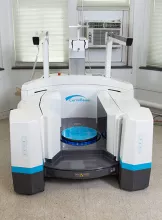Jones Fracture
- For all other requests:
- 1-800-777-8442
If you’re having trouble walking due to pain and swelling on the outside of your foot, you should see an orthopedic specialist right away. You may have a broken bone in your foot known as a Jones fracture (or 5th metatarsal fracture).
Jones fractures occur when you break the proximal aspect of your 5th metatarsal—the bone that connects your pinkie toe to the base of your foot. It could be a complete break that occurs suddenly or a thin crack that develops gradually over time (stress fracture).
Compared to many other broken bones, Jones fractures are unique because they may not heal correctly without surgery.
University of Iowa Health Care’s foot and ankle surgeons have a lot of experience diagnosing and treating Jones fractures. They’re skilled at matching treatment and rehabilitation recommendations to each patient’s age and activity level.
In fact, we routinely help high-performing high school and college athletes get quickly back on their feet and safely back to their sport.
Jones fracture symptoms and diagnosis
Although Jones fractures can happen to anyone, they often affect athletes who frequently twist, change directions, or jump while running.
They’re also common in people whose jobs require a lot of standing and walking, and older adults with osteoporosis.
Symptoms of a Jones fracture
If you have a Jones fracture, you’ll have one or more of the following symptoms:
A sharp pain on the outside of your foot
Difficulty walking
Discoloration or bruising
Stiffness
Swelling
Tenderness
Diagnosing a Jones fracture
If foot pain has you limping, schedule a consultation with an orthopedic expert—like those from UI Health Care.
We’ll diagnose the type and severity of your injury through a physical examination and imaging tests (such as an X-ray, MRI scan, or CT scan). These tests help us:
Confirm that you’ve fractured the 5th metatarsal bone
Assess the severity of the break
See if any other nearby bones are broken
Check whether there is damage to any of the surrounding muscles, ligaments, or tendons
If you have a Jones fracture, we’ll discuss your treatment options. Together we’ll create a plan tailored to the severity of your fracture and your personal goals and preferences.
Jones fracture treatment from UI Health Care
The area of your foot where Jones fractures occur has limited blood flow. This means your injury may take several months to heal.
Our foot and ankle specialists will help you choose nonsurgical or surgical treatments to enhance the healing process.
In some cases, patients with Jones fractures may not need (or want) surgery. This includes people with mild fractures who are not physically active.
Your nonsurgical treatments may include:
-
Immobilization: Wearing a cast or walking boot—with or without crutches—will help you keep weight off your foot while it heals. You’ll probably need to wear or use these devices for six to eight weeks.
-
Rehabilitation: Once your fracture has healed, our physical therapists can teach you exercises to improve your foot and ankle strength, flexibility, and range of motion.
You’ll need to have follow-up imaging exams about eight weeks after your injury to make sure it’s healing properly. That’s because Jones fractures have a relatively high rate of “nonunion” (the bones don’t heal correctly). About one-third of people with Jones fractures experience nonunion.
Without additional treatment—which may require surgery—nonunion can lead to chronic pain and a higher risk of re-injury.
Many people with Jones fractures need (or choose to have) foot surgery. This includes patients who have severe fractures and/or want to return to sports or other activities as quickly as possible.
During the procedure, your surgeon will:
-
Move the broken pieces of bone into their proper place, so they’re in alignment.
-
Insert metal rods, plates, screws, pins, or wires to hold the pieces together—and in place—while they heal. This is called internal fixation.
-
If necessary, insert additional bone (bone graft) to supplement missing bone or strengthen a weak bone.
In most cases, we use a minimally invasive type of surgery called arthroscopy. With this approach, we only need to make a couple of small incisions in the foot. We use a tiny camera and miniature surgical tools to treat the fracture through those incisions.
After surgery, you’ll have to keep weight off your foot—and may need to keep it immobilized—for about 6-8 weeks before starting rehabilitation.
Your total recovery period following a Jones fracture may be shorter if you have surgery instead of nonsurgical treatments.
That’s because a surgical repair decreases your risk of nonunion. We can be more aggressive in prescribing weight-bearing activities that return your foot to its normal strength and function.
We also have a return-to-sport program offered by our sports medicine specialists. This helps athletes get back to pre-injury performance.
Our Care Team


- Emergency Medicine
- Orthopedics and Rehabilitation



- Orthopedics and Rehabilitation








- Orthopedics and Rehabilitation

- Orthopedics and Rehabilitation


- Orthopedics and Rehabilitation


Need treatment for a Jones fracture?
Locations and Offices







Related Health Topics
Patient Stories
Related News
